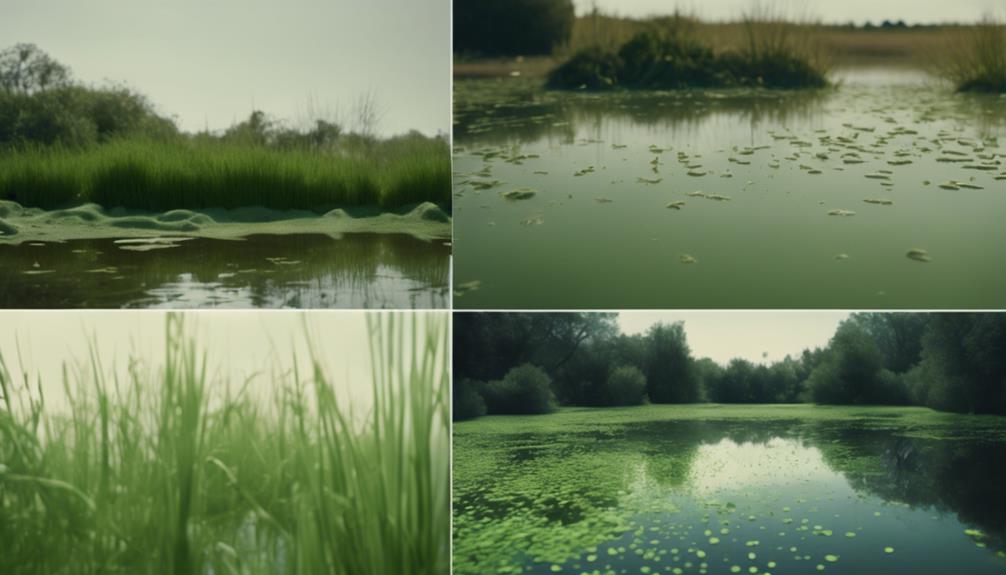You're likely no stranger to the frustrating sight of algae blooms in your pond, but understanding that excess nutrients from sources like grass clippings, fertilizer, and organic debris fuel this growth is key to stopping it. To prevent algae blooms naturally, limit excess nutrients by keeping debris out of the water and planting beneficial vegetation around the pond's edges. Maintaining good water quality, introducing aquatic plants, and controlling nutrient accumulation also help. By addressing the underlying causes and adopting these strategies, you're well on your way to enjoying a crystal-clear pond – and there's more to discover about achieving a balanced ecosystem.
Table of Contents
Key Takeaways
- Excess nutrients from sources like grass clippings, leaves, and fertilizer fuel algae growth in ponds.
- Limiting nutrient entry, maintaining good water quality, and balancing the ecosystem prevent algae blooms naturally.
- Physical removal, aquatic plants, and regular water changes are effective methods for controlling and removing algae growth.
- Installing aeration systems, UV clarifiers, and using biological augmentation can help maintain a balanced and healthy pond ecosystem.
- Addressing underlying causes like poor water circulation and inadequate filtration is crucial for long-term algae control and prevention.
Causes of Algae Growth Explained
When you notice an unsightly layer of green slime coating your pond's surface, it's likely that an imbalance in the water has triggered an algae bloom.
This imbalance can stem from excess nutrients, which fuel algae growth. These nutrients can come from various sources, such as grass clippings, leaves, fertilizer, and other organic debris entering the waterbody.
As a result, floating algae growth can become a significant issue. Additionally, low water temperatures can prevent aquatic plants and fish from becoming active, allowing algae to thrive.
Direct sunlight can also contribute to problems with single-celled Planktonic algae. String algae blooms, on the other hand, are caused by an imbalance in the water feature, with excess nutrients and sunlight playing a significant role in their development.
To Control Algae, crucially, you must address these underlying factors and maintain good water quality. By understanding the causes of algae growth, you can take the first step towards preventing algae blooms and enjoying a healthy, thriving pond ecosystem.
Preventing Algae Blooms Naturally
By taking proactive steps to limit excess nutrients and maintain good water quality, you can effectively prevent algae blooms from occurring naturally.
One key strategy is to keep grass clippings, leaves, fertilizer, and other nutrient-loaded organic debris out of your pond. This will help prevent excess nutrients from entering the water and fueling algae growth.
Planting beneficial vegetation around the edges of your pond can also help absorb excess nutrients and stabilize the bank.
Installing an aeration system can further improve water quality by reducing the accumulation of nutrients.
Additionally, consider biological augmentation, which uses beneficial bacteria and enzymes to consume excess nutrients and maintain a healthy water ecosystem.
By combining these methods, you can create a natural Pond Algae Control system that prevents algae blooms from forming.
Remember, maintaining clean water through proactive management is vital to preventing algae growth.
Maintaining a Balanced Ecosystem

You achieve a balanced ecosystem in your pond by fostering a delicate harmony between aquatic plants, microorganisms, and animals, which in turn helps to regulate algae growth and maintain water quality.
This balance is vital, as it allows your pond to self-regulate and prevent excessive algae growth.
In a balanced ecosystem, aquatic plants absorb excess nutrients and sunlight, which would otherwise fuel algae growth.
Microorganisms, such as beneficial bacteria, break down organic matter and recycle nutrients, while animals like fish and frogs help control algae by feeding on it.
To maintain a balanced ecosystem, you need to guarantee that your pond's water column has a healthy balance of nutrients and sunlight.
This can be achieved by introducing plants that absorb excess nutrients, such as floating plants or submerged plants.
You should also maintain a healthy population of beneficial microorganisms and animals that help control algae growth.
By doing so, you'll create a thriving pond ecosystem where algae growth is controlled, and water quality is maintained.
This, in turn, will result in healthy water that supports a diverse range of aquatic life, and reduces the risk of excessive algae blooms.
Effective Algae Removal Methods
As you explore effective algae removal methods, you'll want to ponder both physical removal and natural prevention strategies.
By combining these approaches, you can create a thorough plan to tackle algae growth in your pond.
Let's take a closer look at the specific techniques that can help you achieve a balanced ecosystem.
Physical Removal
Effective algae removal begins with physical removal, a labor-intensive yet essential step in maintaining a healthy pond ecosystem.
When physically removing filamentous algae growth from your pond, it's pivotal to do so quickly and carefully to prevent string algae spores from being released. You can use your hands or a pond skimmer net to remove the growth, and scissors can be helpful in expediting the process.
Remember to add aquatic plants to compete with algae for nutrients, which can prevent future growth. Regularly cleaning your pond and removing debris can also help prevent algae growth, and performing regular water changes can maintain water quality and prevent algae blooms.
As you physically remove algae, be prepared for a time-consuming process, especially for larger ponds. You may need to repeat the process several times to achieve desired results.
Don't forget to wear protective gear, including gloves and eyewear, to avoid skin and eye irritation.
Natural Prevention
In addition to physical removal, incorporating natural prevention methods into your pond maintenance routine can greatly reduce algae growth. By creating a balanced ecosystem, you can prevent algae from taking over your pond water. One effective way to do this is by adding aquatic plants, which absorb excess nutrients that fuel algae growth. Consider adding plants like water lilies, which provide shade and help reduce sunlight that promotes algae growth.
| Method | How it Works | Benefits |
|---|---|---|
| Adding Aquatic Plants | Absorb excess nutrients, provide shade | Reduces algae growth, improves water quality |
| Introducing Algae-Eating Fish | Consume algae, maintaining balance | Effective in small ponds, low maintenance |
| Aeration and Oxygenation | Increases oxygen levels, reduces stagnation | Prevents green water, promotes healthy ecosystem |
Nutrient Management Strategies

You can substantially reduce the likelihood of algae blooms in your pond by implementing strategic nutrient management practices that target the primary culprits behind excessive algae growth.
Excess nutrients, particularly phosphorus, are the key drivers of algae growth, and preventing their accumulation is vital.
Limit the entry of nutrient-loaded organic debris, such as grass clippings and fertilizer, into your pond.
Plant beneficial vegetation around the pond's edges to absorb excess nutrients and prevent them from entering the waterbody.
Use lanthanum-modified clay or alum to permanently remove phosphorus from the water column and lock it in the pond's sediment.
Evaluate biological augmentation to maintain a healthy water ecosystem and reduce nutrient accumulation.
Proactive Pond Maintenance Tips
As you work to keep algae out of your pond, remember that proactive maintenance is key.
You'll want to focus on limiting excess nutrients and maintaining clean water, as these two strategies are vital to preventing algae blooms.
Limit Excess Nutrients
Excess nutrients pouring into your pond can quickly turn it into a green soup, which is why proactive steps to limit them are crucial.
You can take control of nutrient loading by being mindful of what enters your pond.
Avoid letting grass clippings, leaves, fertilizer, and other nutrient-loaded organic debris get into the waterbody.
Limit mowing around the edges of your pond to establish a protective vegetative buffer that absorbs excess nutrients and prevents them from entering the water.
Plant beneficial vegetation in and around the edges of your pond, such as pickerelweed, sedges, and rushes, to add beauty and provide nutrient absorption.
Establish a protective vegetative buffer of at least 10-15 feet around your pond's edge to filter out up to 60% of phosphorus and 70% of nitrogen from stormwater runoff.
Maintain Clean Water
By incorporating regular water testing into your maintenance routine, you'll be able to identify nutrient imbalances and other issues before they trigger algae growth.
This proactive approach will help you keep your pond's water clean and prevent algae from taking over.
When cleaning your pond, keep in mind that removing debris and decaying plants will reduce the amount of nutrients available for algae to thrive.
Installing UV clarifiers can also help control the growth of algae by targeting the cells that cause it to bloom.
Additionally, you can use surface area to your advantage by incorporating plants that absorb excess nutrients, keeping algae at bay.
Remember, maintaining clean water is key to preventing algae growth.
Regularly test your water's pH, ammonia, and nitrite levels to confirm a balanced ecosystem.
Long-Term Algae Control Solutions

To achieve long-term algae control, you must identify and address the underlying causes of algae growth, including poor water circulation and inadequate filtration, and implement an exhaustive management plan that targets these issues.
This plan should include regular water testing to monitor excess nutrients, which can fuel algae growth.
Some effective long-term solutions to ponder:
- Implement biological augmentation, where beneficial microorganisms break down excess nutrients and organic matter.
- Plant aquatic plants like pickerelweed, sedges, and rushes to absorb excess nutrients and provide shade, reducing the likelihood of algae blooms.
- Install a lanthanum-modified clay or alum treatment system to permanently remove phosphorus from the water column, preventing algae growth and maintaining a balanced pond ecosystem.
- Maintain a well-functioning aeration system, which improves water circulation and increases oxygen levels, making it difficult for algae to thrive.
Frequently Asked Questions
How Do You Prevent Algae in Ponds?
To prevent algae in your pond, you'll want to prioritize pond maintenance with regular cleaning, water aeration, and consider adding algae barriers, UV filters, beneficial bacteria, or pond dyes to create a balanced ecosystem.
What Causes Excessive Algae in Ponds?
You're likely wondering what sparks an algae explosion in your serene pond. It's often a perfect storm of nutrient overload, water stagnation, climate change, aquatic weeds, polluted runoff, inadequate aeration, and fish overpopulation that sets the stage for this unwanted growth.
How to Clear Green Pond Water Naturally?
You can clear green pond water naturally by introducing pond additives like beneficial bacteria, incorporating natural filters like aquatic plants, and utilizing water clarifiers like UV treatment, sediment removal, and biological augmentation.
Does Pond Algae Go Away?
As you observe your pond, you'll notice algae blooms fluctuate with water temperature, weather patterns, and natural fluctuations in the pond ecosystem, supporting aquatic life, but don't worry, they'll likely subside with seasonal changes.
Conclusion
You've now got the tools to tackle that pesky pond algae like a pro!
By understanding the causes of algae growth, maintaining a balanced ecosystem, and implementing effective removal methods, you'll be well on your way to a crystal-clear pond.
Remember, preventing algae blooms is like stopping a leaky faucet – it takes consistent effort, but the payoff is worth it.
Stay vigilant, and your pond will thrive like a well-oiled machine.

